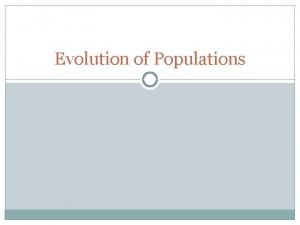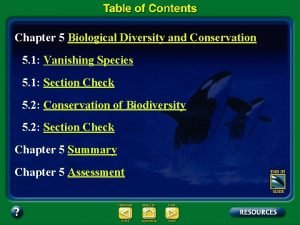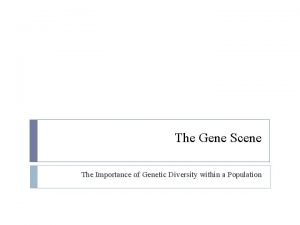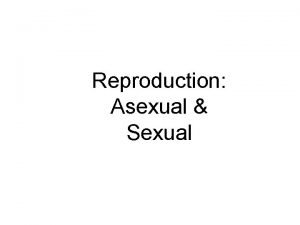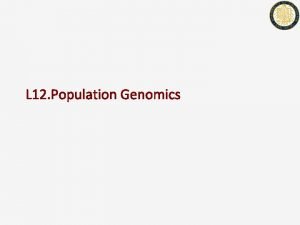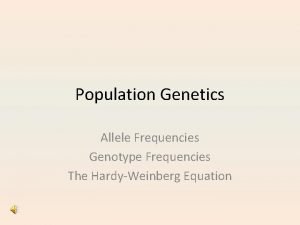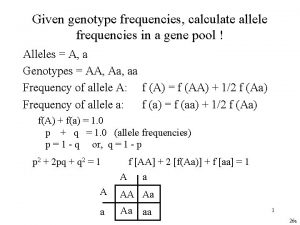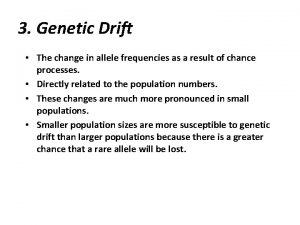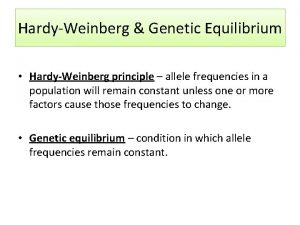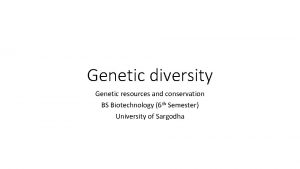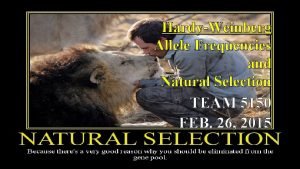Genetic Diversity and Conservation Allele Frequencies The total











- Slides: 11

Genetic Diversity and Conservation

Allele Frequencies The total number of copies of an allele divided by (for mammals) 2 N. Aa AA aa Aa Aa AA aa AA p = 14/26 = 0. 53; q = 12/26 = 0. 47

Heterozygosity – Index of Genetic Diversity Individual Population Aa AA aa Aa Aa AA BB aa cc Aa Dd Aa Aa Aa AA HI – The percentage of loci at which an individual is heterozygous HI = 0. 5 HP – The average heterozygosity in a population. aa AA HP = 0. 461 For multiple loci, we average across loci.

Genetic Diversity and Conservation Population bottlenecks lead to low genetic diversity. 1 – Genetic drift 2 - Inbreeding Loss of diversity increases with length of time the population remains small.

Genetic Diversity and Conservation Population bottlenecks lead to low genetic diversity. Classic Examples Mirounga angustirostris (Sanvito et al. 2013) Acinonyx jubatus (e. g. , Terrell et al. 2016)

Genetic Diversity and Conservation The classical view in conservation is that population viability is intimately linked with genetic variation, especially as measured by heterozygosity. Genetically depauperate species: 1) Will be very susceptible to disease and parasites. DFTD in Sarcophilus Miller et al. (2011) PNAS. 108.

Genetic Diversity and Conservation The classical view in conservation is that population viability is intimately linked with genetic variation, especially as measured by heterozygosity. Genetically depauperate species: 2) Will be subject to inbreeding depression -- decreased sperm viability -- fluctuating asymmetry - breakdown in bilateral symmetry -- decreased growth rates -- lower survivorship to maturity 3) Have decreased evolutionary potential. Even though Sarcophilus have reduced genetic diversity, they have retained alleles that confer resistance and these seem to be sweeping through post-disease populations (Epstien et al. 2016. Nature Comm. 7. ). 50/500 Rule for Minimum Viable Population (e. g. , Jamieson and Allendorf, 2012. TREE 27)

Genetic Rescue Florida panther Puma concolor coryi A population genetic study (Culver et al. 2008. Animal Conservation, 11: 104) indicated that there had been as few as 6 breeding individuals. This persisted for approximately 80 years, leading to dramatic inbreeding depression (low sperm count, malformed sperm, abdominal testes, heart deformations). In 1995, eight females from Texas were introduced to the population in an attempt to inject greater genetic diversity into the population. Hybrid kittens have a 3 -fold higher survival rate than the purebred kittens (Pimm et al. 2006; Animal Conservation), and the population is recovering (Johnson et al. 2010. Science. 329: 1641). A recent meta-analysis of 156 cases (Frankham 2015. Mol. Ecol. 24: 2610) found a large and consistent benefit to genetic rescue.

Challenges to the Classical View 1) Low levels of variability may be ok. The poster children of low genetic diversity are persisting. In cheetahs, this apparently has been the case for 10, 000 years and the species hasn’t gone extinct. Similarly, elephant seals numbers have rebounded in spite of low genetic diversity. 2) There is evidence that some species withstand inbreeding with no depression. Panthera tigris - almost no ill effects of inbreeding in captive populations Canis lupus - and other canids such as the bush dog Speothos Leotopithecus rosalia (Golden lion tamarin) exhibits great deal of inbreeding with no apparent depression.

Challenges to the Classical View 3) Inbreeding can actually increase the fitness of a population in the long run. a. It is possible to actually increase the variation available to respond to selection, especially for polygenic traits, traits that are governed by several genes. b. Inbreeding can result in a decrease in genetic load, the cumulative, fitness-decreasing effect of deleterious recessive alleles that can’t be purged by selection. In an out-bred population, most of the deleterious alleles will be present in heterozygotes (won’t be removed by selection). In inbred populations, deleterious recessive alleles will be expressed more frequently as homozygotes, and therefore will be purged by selection (Garcia-Dorado. 2015. Heredity. 115).

Challenges to the Classical View 4) The alleles that are almost always lost are really low frequency alleles that are likely to be lost due to drift anyway - future adaptation is not actually not likely to be compromised. 5) In even the most genetically depauperate species, the cheetah, the danger of extinction is actually much higher from non-genetic threats (e. g. , habitat destruction).
 Allele frequencies
Allele frequencies Genetic diversity and biodiversity
Genetic diversity and biodiversity Genetic diversity vs species diversity
Genetic diversity vs species diversity Genetic drift vs gene flow
Genetic drift vs gene flow Genetic programming vs genetic algorithm
Genetic programming vs genetic algorithm Genetic programming vs genetic algorithm
Genetic programming vs genetic algorithm Genetic drift vs gene flow
Genetic drift vs gene flow Genetic drift vs genetic flow
Genetic drift vs genetic flow Biological diversity and conservation chapter 5 answers
Biological diversity and conservation chapter 5 answers Chapter 5 section 1 biodiversity
Chapter 5 section 1 biodiversity Why is genetic diversity important
Why is genetic diversity important Advantages of genetic diversity
Advantages of genetic diversity
